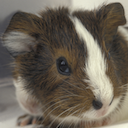The domestic guinea pig (Cavia porcellus), also known as cavy or cuy, is a species of rodent belonging to the family Caviidae. Despite their common name these animals are not in the pig family Suidae, nor do they come from Guinea. They originated in the Andes, and earlier studies based on biochemistry and hybridization suggest they are domestic descendants of a closely related species of cavy such as C. aperea, C. fulgida, or C. tschudii and, therefore, do not exist naturally in the wild. Recent studies applying molecular markers, in addition to studying the skull and skeletal morphology of current and mummified animals, revealed that the ancestor is most likely Cavia tschudii.
Assembly
The Cavpor3.0 assembly was submitted by The Genome Sequencing Platform, The Genome Assembly Team on 2008/03/03 . The assembly is on the Scaffold level, consisting of 61,604 assembled into 3,144 scaffolds. The N50 size is the length such that 50% of the assembled genome lies in blocks of the N50 size or longer. The N50 length for the contigs is 80,583 while the scaffold N50 is 27,942,054.
Other assemblies
- cavPor3 (Ensembl release 80)
Gene annotation
The gene annotation process was carried out using a combination of protein-to-genome alignments, annotation mapping from a suitable reference species and RNA-seq alignments (where RNA-seq data with appropriate meta data were publicly available). For each candidate gene region, a selection process was applied to choose the most appropriate set of transcripts based on evolutionary distance, experimental evidence for the source data and quality of the alignments. Small ncRNAs were obtained using a combination of BLAST and Infernal/RNAfold. Pseudogenes were calculated by looking at genes with a large percentage of non-biological introns (introns of <10bp), where the gene was covered in repeats, or where the gene was single exon and evidence of a functional multi-exon paralog was found elsewhere in the genome. lincRNAs were generated via RNA-seq data where no evidence of protein homology or protein domains could be found in the transcript.
In accordance with the Fort Lauderdale Agreement , please check the publication status of the genome/assembly before publishing any genome-wide analyses using these data.
More information
General information about this species can be found in Wikipedia.
Statistics
Summary
| Assembly | Cavpor3.0, INSDC Assembly GCA_000151735.1, Mar 2008 |
| Base Pairs | 2,723,219,641 |
| Golden Path Length | 2,723,219,641 |
| Annotation provider | Ensembl |
| Annotation method | Full genebuild |
| Genebuild started | Dec 2016 |
| Genebuild released | Jul 2017 |
| Genebuild last updated/patched | Jul 2017 |
| Database version | 115.4 |
Gene counts
| Coding genes | 18,095 |
| Non coding genes | 8,518 |
| Small non coding genes | 4,078 |
| Long non coding genes | 2,654 |
| Misc non coding genes | 1,786 |
| Pseudogenes | 242 |
| Gene transcripts | 34,846 |
Other
| Genscan gene predictions | 59,277 |
